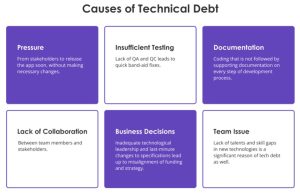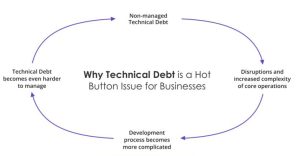When we prioritize immediate success over long-term efficiency, we incur the so-called technical debt (or TD). As the name implies, technical debt occurs when we ignore problems with software architecture or code and rely on shortcuts that are simple to implement but offer only a temporary solution.
According to Edvantis experts, it also should be taken into consideration, that below-par technical decisions, contributing to TD, are nearly inevitable, especially early on. So the common goal here is to get proactive in managing issues asap and avoid letting tech debt grow into an uncontrollable stockpile of problems.
Why is this a big deal? Well, essentially, unresolved technical issues can lead to monetary losses, extended time to market, and productivity disruptions. And repaying it would be similar to paying interest on a loan: time-consuming, restrictive, and costly.
How Do We Accumulate Technical Debt?
A company incurs some technical debt just by existing, as new methods of enhancing the product always appear. According to McKinsey, the percentage of survey respondents’ whole technology estates comprised of technical debt ranges from 20% to 40%. Most Fortune 500 corporations have unpaid tech debt in the hundreds of millions of dollars.

Source: What is Technical Debt and How to Tackle it? – Edvantis
The following are frequent triggers of technical debt:
- Stakeholders put pressure to roll out the app quickly, even if some improvements are still needed.
- A lack of proper testing leads to inadequate “band-aid” solutions.
- Non-documented coding
- Failure to coordinate efforts among team members and other interested parties
- Poor technological leadership
- Specification alterations at the last minute
- Limitations in talent and competence
- Financial and strategic misalignment
The Two Types of Technical Debt
Due to the aforementioned problems, the following forms of technical debt might arise:
- Intentional tech debt
- Unintentional tech debt
Technical dept isn’t always a bad thing. However, how you choose to respond to it will determine how it affects your project. Borrowing money is an excellent option when you need to get something done quickly. Short-term gains in user input on new features could be achieved similarly by using code shortcuts. Therefore, taking on technical debt can be a valuable strategic tool, provided that you do so consciously and are equipped to deal with it later.
Nevertheless, technical debt becomes a major roadblock when it is accumulated owing to external pressures (deadlines, shareholder demands), isn’t repaid, or isn’t even acknowledged as such. Making constant reference to the technical debt could derail the entire effort.
Reasons Why Technical Debt Is a Major Problem for Companies
Unpaid debt that continues to accrue threatens the completion of any undertaking. Money, time, and effort that could have been put toward improving the product are wasted when technical debt isn’t addressed.
Unresolved technical debt often leads to the following results:

Source: What is Technical Debt and How to Tackle it? – Edvantis
- Decreased flexibility
- Discontinuity
- Development time inefficiency
- Troubles with the testing
- Budget losses
- Reduced productivity in the workplace
- Reduced ability to compete
If your project exhibits any of the signs mentioned above, you should try to calculate how much technical debt it already carries. The next step is to take action and employ debt management methods to resolve the situation.
6 strategies for dealing with Technical Debt
Make sure you’re always doing something to pay down your tech debt as soon as you realize you have it. TD may be reduced from 75% to 25% at organizations with aggressive tech debt management. It’s time for you to take action, too. Standard methods for dealing with technical debt are outlined below.
1. Establish an Organizational Definition of “Tech Debt”
Different viewpoints, both technological and business, are required for a project to be successful. Because of these divergent perspectives, however, managers and developers often have quite different conceptions of what technical debt is.
When it comes to TDs, business teams may see increased operational expenses and prolonged time to market as the two most tangible manifestations of the detrimental effects of technical failures on business. TD has a negative impact on the quality of software development, testing, and design in the tech industry. The truth is that both sides have a point, but to resolve the issue, everyone involved needs to share a shared knowledge of the financial and technical ramifications of debt.
2. Clearly Outline a Timeline and Steps to Take to Reduce Tech Debt
You can’t just stop working on a solution if you have an epiphany about what’s wrong. Carnegie Mellon University reports that 65% of respondents knew they had technical debt but had no policies to deal with it. It will need consistent spending of time, money, and effort to eliminate technical debt, so get to work.
Since there aren’t any universal measures for monitoring and assessing technical debt, one approach is to compile a list of things to do and set aside time each week to work on resolving tech debt. In addition, having a formalized framework in place for making decisions on when and how to handle TD activities is helpful. By doing so, IT departments and company heads are more likely to work together to settle any problems that may arise.
Some businesses go above and beyond essential planning to combat TD by establishing dedicated divisions staffed by architects tasked with paying off the accumulated debt.
3. Establish Code Standards and Reviews
The term “code standard” refers to predetermined expectations for how a piece of software should be written. They aid programmers in producing code that is both clean and understandable and can be modified with minimal effort. Standardized coding practices can alleviate technical debt by standardizing what constitutes “good software” and making that definition more apparent to developers.
Developers perform a code review on each other’s projects to check for bugs. In addition to averting problems, this method promotes growth and development inside the group.
4. Adopt Agile Methods of Software Development
Technical debt is best mitigated by making frequent payments toward it, ideally at the end of each sprint. Along with that, using agile software development approaches can assist the team in maintaining a high-quality standard even when working in short bursts.
To facilitate tracking, Agile practices require that all TD tasks be added to the Product Backlog. In addition to keeping technical debt in check, Agile lets you pick the definition of “done” based on your perspective of product quality.
5. Pertain to Automated Testing Activities
In automated testing, software tools are used to verify the code, check for flaws, and verify the software’s quality. Automated testing is typically performed parallel to normal development by software developers and specialized QA engineers.
The elimination of time-consuming and error-prone manual testing is just one way in which automation improves quality control. Additionally, automated tests free up QA teams to focus on more nuanced issues that humans can only address. Technical debt can be eliminated through automated testing because it speeds up the process of finding bugs and requires less human involvement.
6. Commence Refactoring Malfunctioning Code
Refactoring is reorganizing disorderly code to make it more readable, easier to update, and bug-free. This method aids in the transformation of legacy code, which is essential for modernization and reducing technical debt. One of the few strategies to keep technical debt to a minimum is frequently performing minor refactorings. Because restructuring results in clearer code, it simplifies subsequent refactoring tasks. Consequently, this should be viewed as an expense in the interest of future victories over TD.
Conclusion
A certain amount of technical debt is always accrued due to early, less-than-ideal technological choices. It’s essential to take preventative measures to ensure that technical debt doesn’t inflate into an insurmountable snarl of outstanding tasks.
It’s preferable to take preventative actions rather than reactive ones. If you want your project to succeed and keep up with the competition, you need to begin working immediately to reduce the adverse effects of tech debt. The market demands are constantly shifting; thus, we must not let a backlog of faults prevent us from meeting those demands. As the leading software development company, Edvantis will help you tackle all these issues.
Disclaimer: This article contains sponsored marketing content. It is intended for promotional purposes and should not be considered as an endorsement or recommendation by our website. Readers are encouraged to conduct their own research and exercise their own judgment before making any decisions based on the information provided in this article.



































